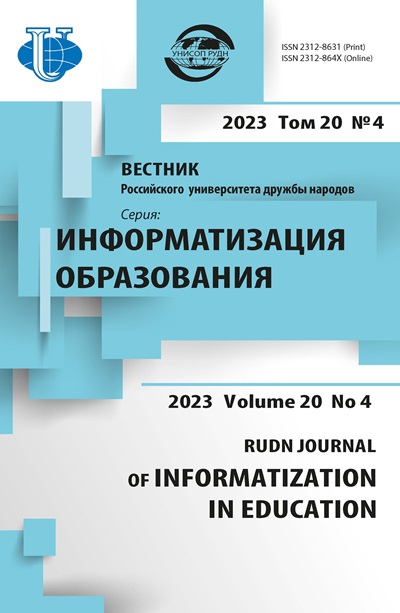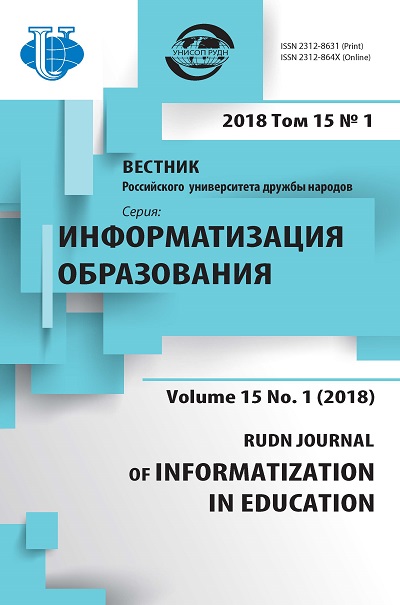Prospects and opportunities for visual programming technologies and tools application in educating at school
- Authors: Kagan E.M.1
-
Affiliations:
- Moscow city pedagogical university
- Issue: Vol 15, No 1 (2018)
- Pages: 18-28
- Section: TEACHING COMPUTER SCIENCE
- URL: https://journals.rudn.ru/informatization-education/article/view/18048
- DOI: https://doi.org/10.22363/2312-8631-2018-15-1-18-28
Cite item
Full Text
Abstract
Article depicts typical problems that students encounter when mastering programming. For each problem, a number of existing specialized software environments offering a solution is displayed. Analyses of programming environments elements and the selection of those who are directly involved in solving problems are conducted. In the end, aggregation of the best solution is carried out and an assumption about the possibility of combining the best elements is made. Initially, the school computer science course was focused on the formation of computer programming and computer skills. Now the main part of the course is devoted to the study of applied software and information technologies. At the same time, classical programming languages developed in the last century are used for learning more. The first successful attempt to create an alternative programming language that could act as an educational tool is the Logo language. A similar display method can be found in many programming environments, where the user does not need to have programming skills, but be able to make a workable algorithm. This allows you not to be distracted by programming language, but to design a program from blocks. Each of the visual programming environments mentioned in the article is not without a number of drawbacks. However, even with this state of affairs, there is a tendency to expand the use of visual programming languages in teaching.
About the authors
Eduard Mikhailovich Kagan
Moscow city pedagogical university
Author for correspondence.
Email: eduard.kagan@yandex.ru
postgraduate student of department of informatization of education Moscow city pedagogical University
Sheremet’evskaja str., 29, Moscow, Russia, 127521References
- Bosova L.L., Bosova A.Ju. Informatika. 5—6 klassy [Informatika. Classes 5—6]: metodicheskoe posobie. BINOM. Laboratorija znanij, 2017. 384 p.
- Bosova L.L., Bosova A.Ju. Informatika. 7—9 klassy [Classes 7—9]: metodicheskoe posobie. BINOM. Laboratorija znanij, 2015. 472 p.
- Grinshkun V.V., Levchenko I.V. Osobennosti fundamentalizacii obrazovanija na sovremennom jetape ego razvitija [Features of fundamentalization of education on the modern stage of its development]. Vestnik Rossijskogo universiteta druzhby narodov. Serija «Informatizacija obrazovanija» [Bulletin of the Russian university of friendship of the people. “Education Informatization” series]. 2011. No. 1. Pp. 5—11.
- Grinshkun V.V. Teorija i metodika ispol’zovanija ierarhicheskih struktur v informatizacii obrazovanija [Theory and methodology of using hierarchical structures in Informatization of education]. Informatika i obrazovanie [Informatics and education]. 2003. No. 12. Pp. 117—119.
- Kuznecov A.A., Zaharova T.B., Zaharov A.S. Obshhaja metodika obuchenija informatike [General methods of teaching computer science]: uchebnoe posobie dlja studentov pedvuzov. M.: Prometej, 2016. 300 p.
- Lapchik M.P., Semakin I.G., Henner E.K. Metodika prepodavanija informatiki [Methods of teaching computer science]: uchebnoe posobie dlja studentov pedvuzov. M.: Akademija, 2001. 624 p.
- Federal’nyj gosudarstvennyj obrazovatel’nyj standart srednego (polnogo) obshhego obrazovanija [Federal state educational standard of secondary (complete) General education]. 2012. URL: https://infourok.ru/federalnyy_gosudarstvennyy_obrazovatelnyy_standart_srednego_polnogo_ obschego_obrazovaniya_2012-414883.htm
- Abelson H., diSessa A.A. Turtle Geometry: The Computer as a Medium for Exploring Mathematics: Turtle Geometry: The Computer as a Medium for Exploring Mathematics. MIT Press, 1986. Pp. 6—9.
- Boytchev P. Logo tree project. 2007. URL: http://elica.net/download/papers/LogoTreeProject. pdf
- Finzer W., Gould L. Programming by Rehearsal // BYTE. 1984. Vol. 9. No. 6. Pp. 187—210.
- Guzdial M. Programming environments for novices: Computer Science Education Research. USA: CRC Press, 2004. — Pp. 127—154.
- Gindling J. LEGOsheets: A Rule-Based Programming, Simulation and Manipulation Environment for the LEGO Programmable Brick // IEEE Computer Society Press. Germany, 1995. Pp. 172— 179.
- Kay A., Goldberg A. Personal Dynamic Media // Computer. 1977. Vol. 10. No. 3. Pp. 31—41.
- Miller P. Evolution of novice programming environments: The structure editors of Carnegie Mellon University // Interactive Learning Environments. 1994. Vol. 4. No. 2. Pp. 140—158.
- Myers B.A. Visual Programming, Programming by Example, and Program Visualization: A Taxonomy // Proceedings of the SIGCHI Conference on Human Factors in Computing Systems. Boston, Massachusetts, USA: ACM, 1986. Pp. 59—66.
- Papert S. Mindstorms: children, computers, and powerful ideas. New York, USA. Basic Books, 1980. 230 p.
- Resnick M. Scratch: programming for all // Communications of the ACM. 2009. Vol. 52. No. 11. Pp. 60—67.
- Sengupta P. Programming in K-12 science classrooms // Communications of the ACM. 2015. Vol. 58. No. 11. Pp. 33—35.
- Sengupta P., Farris A.V., Wright M. From agents to continuous change via aesthetics: learning mechanics with visual agent-based computational modeling // Technology, Knowledge and Learning. 2012. Vol. 17. No. 1/2. Pp. 23—42.
- Smith D.C. Pygmalion: a computer program to model and stimulate creative thought. Birkhauser, 1977. Vol. 40. Pp. 77—87.
- Soloway E. Learning to Program = Learning to Construct Mechanisms and Explanations // Commun. ACM. New York, NY, USA, 1986. Vol. 29. No. 9. Pp. 850—858.
- Sutherland I.E. Sketchpad: A Man-machine Graphical Communication System // Proceedings of the May 21-23, 1963, Spring Joint Computer Conference. Detroit, Michigan: ACM, 1963. Pp. 329—346.
- Wagner A. Using app inventor in a K-12 summer camp // Proceeding of the 44th ACM technical symposium on Computer science education. ACM. 2013. Pp. 621—626.
















